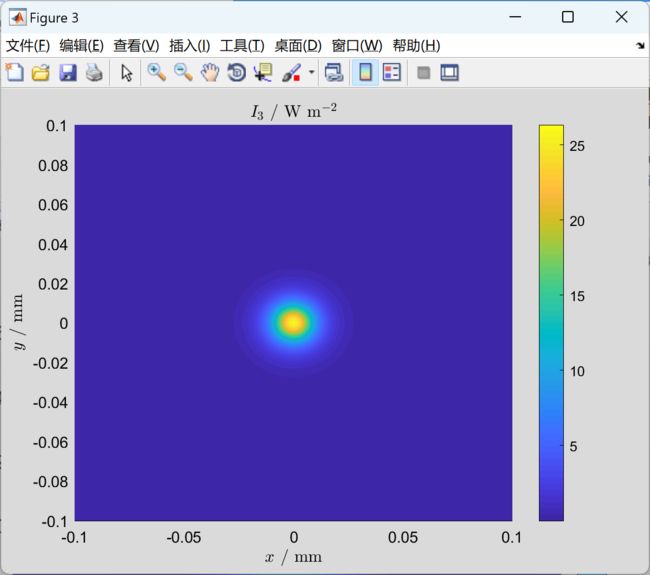【基于矢量射线的衍射积分 (VRBDI)】基于矢量射线的衍射积分 (VRBDI) 和仿真工具(Matlab代码实现)
欢迎来到本博客❤️❤️
博主优势:博客内容尽量做到思维缜密,逻辑清晰,为了方便读者。
⛳️座右铭:行百里者,半于九十。
本文目录如下:
目录
1 概述
2 运行结果
3 参考文献
4 Matlab代码实现及详细文章讲解
1 概述
-
基于矢量射线的衍射积分(Vector Ray-Based Diffraction Integral,VRBDI)是一种用于模拟光的衍射现象的方法。它基于矢量射线追踪技术,通过对光波的传播路径进行追踪和积分,来计算衍射图样。VRBDI方法可以用于模拟各种衍射现象,包括光栅衍射、衍射光栅、衍射孔径等。
VRBDI方法的基本思想是将光波看作是由许多矢量射线组成的,每条射线具有位置、方向和振幅等属性。通过追踪这些射线的传播路径,并根据衍射积分的原理进行积分计算,可以得到衍射图样的近似解。VRBDI方法可以考虑光的波动性和干涉效应,适用于模拟复杂的衍射现象。
在VRBDI方法的实现中,通常需要借助计算机仿真工具来进行数值计算和模拟。一些常用的仿真工具包括:
-
MATLAB:MATLAB是一种常用的科学计算和仿真工具,它提供了丰富的数值计算和图形绘制函数,可以用于实现VRBDI方法的数值计算和模拟。
-
Zemax:Zemax是一种专业的光学设计和仿真软件,它提供了强大的光学建模和分析功能,包括衍射现象的模拟和分析。可以使用Zemax来实现VRBDI方法的仿真。
-
VirtualLab:VirtualLab是一种专业的光学仿真软件,它提供了全面的光学建模和仿真功能,包括衍射、干涉、衍射光栅等现象的模拟和分析。可以使用VirtualLab来实现VRBDI方法的仿真。
这些仿真工具都具有强大的功能和灵活的使用方式,可以根据具体的需求选择合适的工具进行VRBDI方法的实现和仿真。
-
-
详细文章讲解见第4部分。
2 运行结果
本文一共分为五个部分,这里仅展现第一部分结果图。
部分代码:
%Definitions (all lengths in mm, wavelength in nm)
lambda=532; %Wavelength
w0=2.3; %Gaussian waist radius
zw=-10000; %Distance from waist (negative value => beam convergent)
z0=10; %Distance from input plane to front lens apex
z1=1; %Distance from rear lens apex to intermediary plane
n=Sellmeier(lambda,'AIR'); %Refractive index immersion medium
b1=15; %Edge length of square-shaped input window
b2=15; %Edge length of square-shaped intermediary window
b3=0.2; %Edge length of square-shaped output window
Pix1=55; %Pixels along one dimension of input window
Pix2=99; %Pixels along one dimension of intermediary and output
%window
%Lens parameters THORLABS LBF254-050-A ####################################
RL1=30.06; %Front curvature radius
RL2=-172; %Back curvature radius
TL=6.5; %Center thickness
fB=46.4; %Back focal distance
ApL=12.7; %Aperture radius
nL=Sellmeier(lambda,'N-BK7');
%Remaining distance after lens to focal region
z2=fB-z1;
%Definition of lens component and initialization of System ################
SL=AddSurf([0 0 0],RL1,ApL,n,nL,-1,1); %Initialization surface list SL
SL=AddSurf([0 0 TL],RL2,ApL,nL,n,-1,1,SL); %Appending surface to SL
Lens=DefComp([0 0 z0],[0 0 0],SL); %Definition of Lens
System=AddComp(Lens); %Initialization of System with
%Lens
%Definition of detector component and addition to System ##################
SL=AddDet([0 0 0],1e30,1e30,n,0); %Detector size should be large
Det=DefComp([0 0 z0+TL+z1],[0 0 0],SL); %to catch all remaining rays!
System=AddComp(Det,System); %Appending Detector to System
%Definition of spatial point grids ########################################
[X1,Y1]=meshgrid(-b1/2:b1/(Pix1-1):b1/2);
[X2,Y2]=meshgrid(-b2/2:b2/(Pix2-1):b2/2);
[X3,Y3]=meshgrid(-b3/2:b3/(Pix2-1):b3/2);
%Reshaping of input and output grids for VDI propagation ##################
P2=[X2(:) Y2(:) 0*X2(:)];
P3=[X3(:) Y3(:) 0*X3(:)+z2];
%Definition of tangent electric field components on input plane ###########
E1x=GaussianField(w0,zw,lambda,n,b1,Pix1);
E1y=zeros(Pix1);
%Get irradiance and other field components on input plane #################
[I1,E1z,H1x,H1y,H1z]=GetIrrad(E1x,E1y,lambda,n,b1,b1);
%Get plane wave spectrum from input field ################################
3 参考文献
部分理论来源于网络,如有侵权请联系删除。
[1] B. Andreas, G. Mana, and C. Palmisano, "Vectorial ray-based diffraction integral," J. Opt. Soc. Am. A 32, 1403-1424 (2015).
[2]陈光炜, 陈光炜. 光学与光谱学实验指导[M]. 科学出版社, 2015.
[3]李大鹏, 李大鹏. 光学实验指导[M]. 高等教育出版社, 2017.


